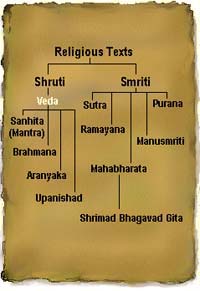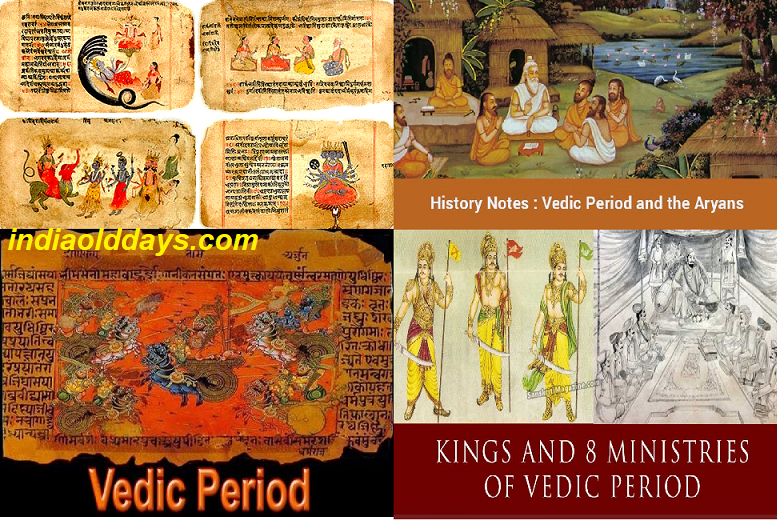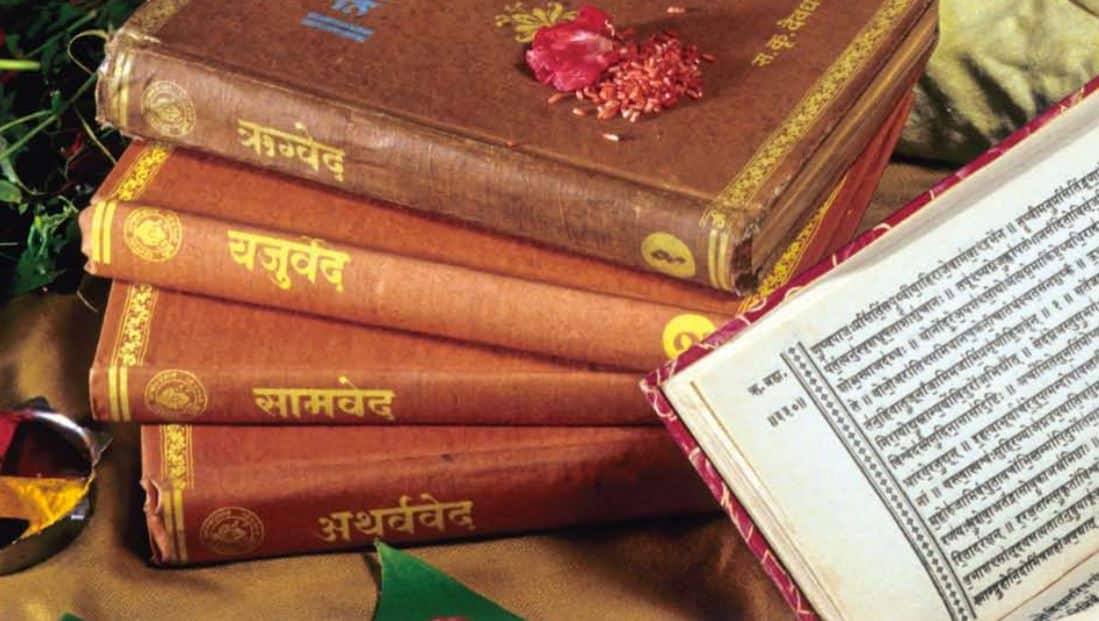No products in the cart.
The Vedas are a major source of religious texts from ancient India. Compiled with Vedic Sanskrit, the texts form the oldest Sanskrit text as well as the oldest Hindu texts.
There are four types of Vedas: Rigveda, Yajurveda, Samaveda and Atharvaveda. Each Veda has four sections – Samhitas means mantras and nedictions,Aranyakas means text on rituals, ceremonies, sacrifices and symbolic sacrifices, Brahmanas means comments about rituals, ceremonies and sacrifices, and the Upanishads means texts on meditation, philosophy and spiritual knowledge. Some scholars add a fifth element – the Upasanas which means worship. The Upanishads texts discuss ideas similar to heterodox sramana-traditions.
The Vedas are shruti meaning audible, distinguishing them from other religious texts, called smṛti meaning “memorable“. Hindus think of the Vedas to be pauruṣeya, meaning “not human, supernatural” and “impersonal, powerless,” revelations of sacred sounds and writings heard by ancient scholars after deep meditation.
The Vedas existed orally and were passed down from master (guru) to student(shishy) for generations until they committed themselves to writing between c. 1500 – c. 500 BCE in India. They were carefully preserved orally as the craftsmen made the students memorize them forwards and backwards emphasizing precise pronunciation to preserve what sounded complete.
What is Veda?
The Sanskrit word “Veda” is derived from the origin of vid which means “to know, to discover, to understand“. Hence the word “Veda” means “knowledge“. The things you understand, will increase your knowledge. In some parts of southern India, Vedas are known as Marai or Vaymoli. Marai which means “hidden, secret, mysterious“.
The ideas, doctrines, and practices described in the Vedas form the basis of the six major schools of Hindu philosophy – Nyaya, Vaisheshika, Samkhya, Yoga, Mimamsa and Vedanta.
These are the religious of the religion of Hinduism. They are considered to be the oldest religious literature known, if not the oldest of the world. They are also referred to as “sacred writings”, which means that they can be defined as the sacred text of the spiritual nature. Unlike the writings of other religions, however, the Vedas are not considered to have been revealed to any person or persons at any particular time in history. The Vedas accounts to the work of great heroes and the struggles they faced in their life such as Mahabharta, Ramayana and Bhagwat Gita( it is actually considered as Shruti in Hinduism).
Origin of Vedas
No one knows the origin of the Vedas, although many scholars and theologians have come up with various theories on this subject. It is widely believed (though not universally accepted) that Vedicism came to India in the form of nomadic Aryan tribes who emigrated  from Central Asia sometime around the 3rd century BCE The word “Aryan” should be understood literally as being the people of the day, which means “respected” or “free”, a class of particular people, not a Caucasians, not race (as claimed by Western 18th and 19th century CE scholars). These Indo-Aryans are thought to have separated from a large group of Indo-Iranians who settled in the region of present-day Iran and were known in the West (by the Greeks) as Persians. The similarities between Early Iranian Religion (and later Zoroastrianism) and early Hinduism suggest a system of similar beliefs, which were later developed separately.
from Central Asia sometime around the 3rd century BCE The word “Aryan” should be understood literally as being the people of the day, which means “respected” or “free”, a class of particular people, not a Caucasians, not race (as claimed by Western 18th and 19th century CE scholars). These Indo-Aryans are thought to have separated from a large group of Indo-Iranians who settled in the region of present-day Iran and were known in the West (by the Greeks) as Persians. The similarities between Early Iranian Religion (and later Zoroastrianism) and early Hinduism suggest a system of similar beliefs, which were later developed separately.
Indo-Aryan Migration theory states that the Vedic concept was developed in Central Asia and brought to India during the decline of Harappan civilization (c. 7000-600 BCE) between c. 2000-1500 BCE, combining traditional beliefs with their own.
As records show, the Vedas- which means knowledge, originated in the Indian Subcontinent. Its written history dates back to 1600 BCE The Rig Veda, the oldest of the 4 Vedas, was written about 1600 BCE However, there is no definite date for the formation of the Vedas as the emergence of texts in the Vedic period was the oral tradition, which was a precise and detailed strategy.
The present ones date from somewhere between the 11th and 14th centuries, largely because of the temporary nature of the manuscripts; birch bark or palm leaves.
Legends tell people that they did not compose the famous Vedas’ songs. However, the knowledge was acquired through deep meditation and sadhana (Yogic practice) by ancient scholars, who passed it on orally from generation to generation.
Also, Vedic philosophy views the Vedas as Apurusia, that is, not human or non-human. According to the Vedanta and Mimamsa religious philosophies, the Vedas are considered Svatah Pramana (Sanskrit, meaning “the means by which knowledge manifests itself”).
Some schools of thought even assert that the Vedas are eternal beings, especially in the Mimasa culture. In the Mahabharata, the creation of the Vedas is attributed to Brahma, the Supreme Creator. However, Vedic hymns insist that they were cleverly created by Rishis munis after inventing inspired material.
Also, there are good reasons to recognize the motive, at least, of any claim (although OIT is rejected by ordinary academics) and experts seem to hold on to one or more personal reasons than any other objective, scholarly study. The most logical answer to the question of origin and dating in the Vedas is that one does not know. Man’s need for a solution to what appears to be a mystery, however, keeps the debate alive today.
When and What was “The Vedic Period”
The Vedic era, or Vedic period, is a period in Indian history between the end of the Indus Valley Civilization and the beginning of the second settlement in the heart of the Indo-Gangetic Plain in about 600 BCE, when the Vedas were formed in northern India. a small continent.
 In India, the Vedic period includes the Late Bronze and the Early Iron Ages. After the Indus Valley civilization, it began in northern India. Brahmanical philosophy contributed to the development of various Vedic texts during the Great Depression, which was an integral part of the Indo-Aryan tribes.
In India, the Vedic period includes the Late Bronze and the Early Iron Ages. After the Indus Valley civilization, it began in northern India. Brahmanical philosophy contributed to the development of various Vedic texts during the Great Depression, which was an integral part of the Indo-Aryan tribes.
The Vedas period (c. 1500 – c. 500 BCE) is a period in which the Vedas committed themselves to writing, but this has nothing to do with the age of the ideas or oral traditions themselves. The term “Vedic Period” is a modern formulation, based on evidence of Indo-Aryan migration, which, as noted, is not universally accepted. However, that theory is generally accepted as historically accurate based on available evidence.
The religious beliefs of the people of Harappan Civilization are unknown as they do not leave written literature. Archaeological excavations at Mohenjo-daro, Harappa, and other sites suggest a highly developed religious structure that involves ritual bathing and a form of worship. The only clear evidence of religious belief and practice comes from the image of the natural spirits known as the yakshas that originated before c. 3000 BCE in an unusual and continuous way, with great refinement, in the first century BCE.
It seems that the Yaksha Cults were focused on the daily need (if one interpreted the evidence associated with ancestral religions) as the spirits could either be kind or hateful, and sacrifices were made for the sake of grace requested or to avoid injury. As in Asian ancestral religions, there has been no emphasis on the “great image” of a person’s origin, his purpose, or his destination after death. These were the questions answered by the original Vedas, the Rig Veda (meaning “Knowledge of Wisdom”, “Verses of Wisdom” or, literally, “Knowledge of Praise”) that introduced the other three.
The 4 Vedas
There are four Vedas: Rig Veda, Yajur Veda, Sama Veda and Atharva Veda, all of which are collectively referred to as ‘Chaturveda.’.

Each Veda is divided into four major types of text or four sections.
- The Samhita, the oldest known Vedas script, consisting of translated words, hymns, prayers, and blessings combined or incorporating the other three texts;
- Aranyakas, who formed the philosophy after the traditional sacrifice,
- Brahmanas, which contains the meanings of songs for the four Vedas once
- The Upanishads, which include discussions between teachers and students, clarify the philosophical message of the Vedas.
- The Rig Veda
The Rig Veda is the oldest and most famous of the four Vedas. The two Sanskrit words Rig and Veda are translated ‘praise or glory’ and ‘knowledge’ respectively. A collection of 1,028 songs and 10,600 verses are organized into ten different Mandalas (or books; Sanskrit). He is also the principal and oldest of the four Vedas.
Like the other three Vedas, many view the Rig Veda as Apauruṣeya, that is, it does not belong to a person or a person and does not belong to a particular author. The hymns and verses were written by the Rishi, and as the devout believers of the Sanatana dharma claim, the revered King himself taught Vedic hymns to the sages, who then transmitted them from generation to generation by word of mouth.
The Rig Veda is further divided into four sections, Samhitas or hymns singing hymns to Rig Vedic deities, some of which are Indra, Agni, Soma, Ushas, Varuna, and Ishwara, the supreme God. Brahmans have a meaning of ancient sacred rites; Aranyakas combine the philosophy behind the traditional sacrifice with the Upanishads, commonly called Vedanta.
Rigveda, in Hinduism of that time, was a monument to ancient values and a source of pride for Hindus, with other hymns still used in major passing ceremonies. However, for some experts, the actual acceptance of the text is long overdue.
- The Yajur Veda
Yajur Veda, originally from Sanskrit, is composed of Yajus and Veda; both terms translate ‘translate words devoted to reverence or respect for religion’ and knowledge. Third of the four Vedas, this set of rituals is known as ‘a book of rituals.’
Yajur Veda is a ritual combination that gives formulas or prose words that should be sung or recited repeatedly by a priest. At the same time, one performs rituals that are confirmed before the fire of sacrifice or Yajna.
Yajurveda is widely integrated into Krishna Yajurveda and Shukla Yajurveda, also known as Black Yajurveda and White. Regarding Krishna Yajurveda verses as random, ambiguous, and inconsistent or inconsistent, the collection is often referred to as Black Yajurveda. In contrast, well-organized and expressive, Shukla Yajurveda is known as White Yajurveda.
Yajurveda, in Hinduism of that time, was a monument to ancient cultural values and a point of Hindu pride. The text is a useful source of information about agriculture, economics, and social life during the Vedic period. This verse, translated from Shukla Yajurveda, mentions a variety of plants that were considered important in ancient India.
- The Sama Veda
Rig Veda lyrics are included in the music and should be sung rather than just read or recited. The Sama Veda, also the Veda of Melodies and Chants, is the third of the four Hindu texts – the four Vedas.
Commonly called the ‘Book of Songs,’ it is derived from two words, Saman, Sanskrit, meaning Song, and Veda, meaning knowledge. Sama Veda has served as a major source of ancient Indian music and dance
The Sama Veda is divided into two main parts: collections of four songs, or Saman, songs and the latest Arcika, or verse books, a collection (Samhita) of hymns, hymns, and divided verses. The text of the service relating to public service, all except 75 verses of 1875, is taken from the Rig Veda.
If one could summarize the significance of the Sama Veda in one line, the Sama Veda, in modern Hinduism, was a monument to the glorious ancient cultural values and a point of Hindu pride; not to mention that it is still in use today.
- The Atharva Veda
The fourth and final author of the Hindu dharma text, the Vedas, the Atharva Veda, in short, is represented as the “Atharvāṇas” archive of Atharvāṇas i.e., formulas, spells aimed at combating disease and disaster, or “processes in everyday life.”
Late addition to the Vedic texts, the word is derived from Sanskrit, and the widely used epithet of the text is the ‘Veda of Magic formulas.’ It is in line with the popular culture and tradition of the day rather than preaching religious and spiritual teachings. . It is generally not considered in relation to the other three Vedas but as a clear text.
Atharvaveda is a collection of 20 books, with a total of 730 songs with about 6,000 sections. According to the text, says Patrick Olivelle and other scholars, it is a historical set of beliefs and practices that reflect the realities of daily life in the Vedic community, and it is not a collection of Yajurvedic rituals.
The Atharva Veda is still discovering its significance in modern society. It has been a pioneer in influencing modern medicine and health care, culture and religious ceremonies, and even writing culture on the small Indian subcontinent. Contains the oldest known speech expression of Indic texts. The fourth and final four Vedas are still one of the most popular books of the Vedas today.
At last we can conclude that, The Vedas, especially the Upanishads, would eventually build a basic understanding of Sanatan Dharma and provide direction and purpose to the lives of the followers. It was understood that there was one organization, Brahman, that not only created the existence but also the existence itself. As the organization was large enough to be understood by humans, it became more and more like an icon representing images such as Brahma (creator), Vishnu (guardian) and Shiva (destroyer) and countless other gods, all of whom were actually Brahman. The purpose of human life was to see the supreme being (Atman) and perform the dharma (work) the person was given through proper karma (action) in order to free himself from the cycle of rebirth and death (samsara) which was manifested in the suffering and loss man experienced in the physical world. When a person broke these bonds, the Atman of that person returned to Brahman with eternal peace.






